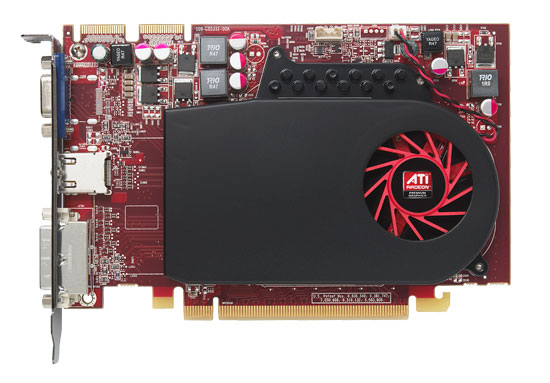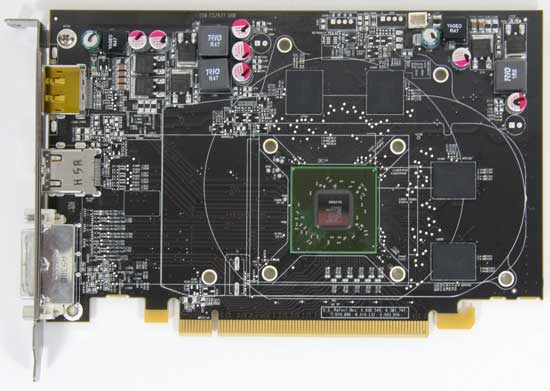AMD's Radeon HD 5670: Sub-$100 DirectX 11 Starts Today
by Ryan Smith on January 14, 2010 12:00 AM EST- Posted in
- GPUs
Meet The 5670
Today’s launch is the Redwood based Radeon HD 5670. The 5670 is a full Redwood card, with all of its functional units enabled and running at its “full” clockspeed. The card we’re looking at is clocked at 775MHz core, and 1GHz(4GHz data rate) on the GDDR5 RAM. With a 128-bit memory bus, this gives the card 64GB/sec of memory bandwidth.

AMD stock photo, our sample boards are black and don't have CF connectors
AMD will be launching the card in a 512MB and 1GB configuration. The $99 card we’re looking at is a 512MB model, while the 1GB model will run $15-$20 more.

Attached to the card are 4 128MB Hynix GDDR5 RAM chips. These chips are specified for a 4GHz data rate, so AMD is only finally pairing up 5000-series cards with appropriately fast RAM. What this means is that unlike the 5700 and 5800 series, there won’t be any freebie memory overclocking to take advantage of the gap between the card’s clocks and what the RAM is specified for. What you see is what you get.
As is common for cards targeted at the sub-$100 price range, the 5670 runs sans external power. AMD puts the TDP for the card at 61W, which compares favorably to the 70W of the GT 240 that we saw last week. AMD tells us that they were merely designing this card to be under 75W, and that the 61W TDP of the shipping product is a good bit lower than they had been planning on.
With the lower power usage of this card, the need for a dual-slot cooler (and the 5000 series distinctive shroud) is gone. The 5670 is equipped with a slightly larger than normal single-slot blower, which blows air towards the front of the card. We call this cooler slightly larger than normal since AMD has extended the heatsink portion slightly to cover all of the GDDR5 RAM chips on the card, as evidenced by the heatsink jutting out of the top. This is an interesting design choice from AMD, since other cards like the 5750 do not apply any cooling to the GDDR5 RAM chips. This does leave us wondering whether cooling the RAM is necessary, or if AMD is doing it for cosmetic reasons.

The card measures at 6.61”, and finally drops AMD’s traditional Eyefinity port configuration. By moving to a single slot, AMD has dropped the 2nd DVI port, leaving the card with a DisplayPort, an HDMI port, and a dual-link DVI port. The card will be able to drive a second DVI monitor using an HDMI-to-DVI adapter, although only a single link. The 5670 still has full Eyefinity capabilities, and a 3rd monitor can be hooked up to the DisplayPort for that task. AMD tells us that the Redwood chip can actually drive 4 monitors, but none of the launch cards will configured for that (not that the 5800 cards were either). AMD’s ideal Eyefintiy configuration for this card is to pair it up with a trio of cheap 16:9 19” monitors, although as we’ll see the card doesn’t really have enough power for gaming like this.
The need for an active DisplayPort adapter is still an issue however, and at $99 the adapters are as much if not more than the card itself. At this point the best solution is a DisplayPort native monitor, but those are still fairly rare and seldom cheap.










73 Comments
View All Comments
krumme - Thursday, January 14, 2010 - link
KO 1 roundShadowmaster625 - Thursday, January 14, 2010 - link
Where is the 4770 and 9800GT??? A lot of the the data makes me skeptical because it doesnt mesh with what I'm seeing on other sites. I'm more inclined to trust the other reviews because they used common sense and compared this card to more cards in its own price range. Common sense is your friend. Notice how close the 5670 and 5750 are in terms of load power. That dont make sense at all.Ryan Smith - Thursday, January 14, 2010 - link
The 9800 GT is the same as an 8800 GT. As for the 4770 it's here too, although I don't have any 19x12 data for it since that resolution was a last-minute decision (I only had 30 hours or so with the 5670).ereavis - Thursday, January 14, 2010 - link
Common sense dictates that if a 4770 performs like a 4850 clone in most cases, leave it out for saturation purposes. Same case for the 9800GT, GTS 250 is a rebranded 9800GT, near identical performance.Price point? 9800GT and 4770 are next-to-unavailable, so what price should be used on something that can't be bought (in the near future when 5670 is all that's left on ATI side and GT 250 for nVidia but this review is still sitting on this site).
How can a power meters measured numbers "not make sense"? A much better performing 5750 at near 5670 power usage just means inefficiency at 5670 performance, which is common for lower performance parts on similar fab.
Explanation of the above would be a bonus, but hardly required, great review.
daytrader7 - Thursday, January 14, 2010 - link
4850's for 99 bucks a pair?Methinks not.
silverblue - Thursday, January 14, 2010 - link
No I think he meant that he'd seen a couple of instances where a 4850 was priced as low as $99, not that it costs $99 to have two of them.If it only cost that, hell I'd import two myself.
daytrader7 - Thursday, January 14, 2010 - link
Ahh...2 different 4850's available @ 99.00 each.
Misinterpretation on my part.
Zool - Thursday, January 14, 2010 - link
Also want to note that without real nvidia cards for amd it seems enough just to beat the weak nvidia setup and thats all.Eyfinity is just plain stupid on these level of cards for games. Real DX11 games on these performance levels is questionable at least too.
Both 5700 and 5600 are VERY weak for the price they sell. I wouldnt recomend them to anyone if they own a 4800 or 4600 series card, just in case they need a new card in a new machine.
The feature set with new generation of cards, including audio bitstreaming should be a MUST and not a priced upgrade put in the cards cost. Iam quite dissapointed form the amd-s 5600 and 5700 series cards. The only real new cards are the radeon 5800-s.
MadMan007 - Thursday, January 14, 2010 - link
I agree with Zool. The 5800s are the only true advancement among this 5000 series. They actually improved performance and price/performance (well, until pricing got out of hand because of supply) over their equivalent lineup predecessors and against their competition from NV. The 5700s and apparently 5600s are just spinning wheels performance-wise: they are feature upgrades not performance upgrades. That makes them mildly disappointing and not an easy purchase decision.marc1000 - Friday, January 15, 2010 - link
I had a 3850. Buying a 5770 was a fairly easy decision to me. I wanted the 5850 in fact, but to buy this one I would need to change my PSU too and that would be too expensive. So the 5770 it was! And I'm pretty glad with the performance. Remember that not everyone has the latest board from previus generation. ATI/AMD is doing a great job.